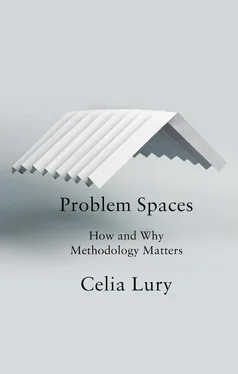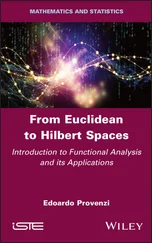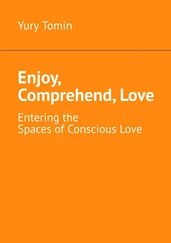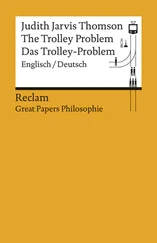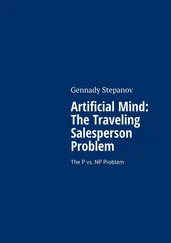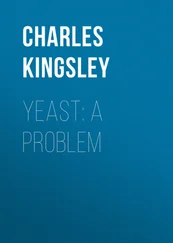In describing figuration in this way, Haraway might be seen to call up what Hayden White, in a commentary on the literary theory of Erich Auerbach, describes as figural causation, a concept that speaks to the potential of a figure for progressive fulfilment (Erfüllung), a kind of ‘anomalous, nondetermining causal force or ateleological end’ (White 1991: 88): ‘the later figure fulfils the earlier by repeating the elements thereof, but with a difference’ (White 1991: 91). However, in discussions of the practice of string figuring, Haraway seeks to distance herself from the Judeo-Christian temporalities of salvation or damnation. In contradistinction, she identifies three key features of string figuring or sf as methodological practice:
First, promiscuously plucking out fibers in clotted and dense events and practices, I try to follow the threads where they lead in order to track them and find their tangles and patterns crucial for staying with the trouble in real and particular places and times. In that sense, sf [string figuring] is a method of tracing, of following a thread in the dark, in a dangerous true tale of adventure, where who lives and who dies and how might become clearer for the cultivating of multispecies justice. Second, the string figure is not the tracking, but rather the actual thing, the pattern and assembly that solicits response, the thing that is not oneself but with which one must go on. Third, string figuring is passing on and receiving, making and unmaking, picking up threads and dropping them. sf is practice and process; it is becoming-with each other in surprising relays; it is a figure for ongoingness. (2016: 2)
In developing this understanding, she emphasizes that string figures ‘are not everywhere the same game’: as she says, ‘Like all offspring of colonizing and imperial histories, I – we – have to relearn how to conjugate worlds with partial connections and not universals and particulars’ (2016: 12). 9
The fourth approach introduced here is not that of the French author François Jullien himself but is, rather, his account of the Chinese concept of shi , sometimes translated as potential, a set-up, disposition, position or circumstance.
Jullien (2004) describes shi as ‘a tendency that stems from a situation’ and ‘which, once set off, cannot be arrested’. (In my use of Whitehead’s vocabulary, it is compulsive.) Jullien observes that the concept of shi initially emerged in the realm of Chinese military strategy and politics but evolved to have a much broader philosophical meaning. He explicitly contrasts it with the Western practice of fixing one’s eyes on a model, a practice in which, he suggests, efficacy is conceived in terms of abstract, ideal forms, set up to be projected onto the world as a goal to be attained. In contradistinction, shi is associated with a concept of efficacy that ‘teaches one to learn how to allow an effect to come about: not to aim for it (directly) but to implicate it (as a consequence), in other words, not to seek it, but simply to welcome it – to allow it to result’ (2004: vii).
Jullien’s focus on shi as propensity allows him to reconfigure traditional Western philosophical concerns: ‘the fact is that, beneath the question of efficacy, another gradually surfaces: not the question of being and knowing, which is constantly raised by metaphysics, nor that of action, which is its ethical corollary, but the question of the conditions of effectiveness’ (2004: viii). He continues:
To move on from the question of efficacy, which still bears the imprint of voluntarism, to that of efficiency, which implies an underlying fund of immanence, we need to attempt a shift. A shift in two senses of the term: a shift away from our normal thinking habits, a move from one framework to another – from Europe to China and back again – which will undermine our representations and get our thoughts moving; and also a shift in the sense of shifting the impediment that is preventing us from perceiving what we have always blocked out of our thinking and, for that very reason, have been unable to think about. (2004: viii)
This is a point of difference with Dewey, whose ethics of thought is also concerned with efficacy. As Stengers summarizes, while for Dewey, the ‘question of the truth … is not situated in the true/false alternative, but poses the question of its efficacy’, she also notes that this efficacy is understood in terms of ‘its possible power of breaking through indifference and of engaging and obliging one to choose’ (2009: 10). However, in acknowledging Dewey’s use of the term ‘choice’ she distinguishes his understanding from that of rational choice and adds, ‘It is no longer a worldly choice – what should one choose to be or do in this world? – but a choice for the world to which it is a matter of contributing. This choice doesn’t only imply a world in the making; it affirms a world whose components are themselves indeterminate, whose ‘perfectibility’ depends on the jumper’s trust that he may connect with ‘other parts’ that may become an ingredient in its fabric’ (2009: 11).
In Jullien’s understanding of Chinese thought, context or circumstances are no longer something unpredictable, to be controlled, eliminated or excluded in experimental conditions. Instead, because of their variability, circumstances can be turned to advantage by the propensity emanating from the situation. Jullien writes:
Now circumstances are no longer conceived only (indeed, at all) as “that which surrounds” ( circumstare ), that is to say, as accessories or details (accompanying that which is essential in the situation or happening – in keeping with a metaphysics of essence). Instead, it is through those very circumstances that potential is released, the potential, precisely, of the situation. (2004: 22)
Within this antagonistic process there is constant interaction: ‘“the potential of the situation is whatever profits from that which is variable”’ (Wang Xi, quoted in Jullien 2004: 22). Jullien concludes:
The whole of Chinese thought about efficacy reverts to a single act: that of “returning” to the fundamental “basis,” that is to say, the starting point of something that, as a condition, subsequently carried forward by the evolution of things, will gradually impose sway of its own accord. In such circumstances, an effect is not merely probable, as it is in a constructed relation of means to an end, but will unfailingly result, spontaneously. (2004: 45)
As he concludes, the ‘way’ (the dao ), as conceived traditionally in China, ‘is a far cry indeed from our Western method ( methodos , which is a “way” to be “pursued” that leads “toward” something)’ (2004: 33).
The methodological potential of the situation
These two approaches are as different to each other as the first two, but they are paired here to indicate some resources to further develop the understanding of problem space as a space of methodological potential. As indicated in the Introduction, conventional understandings of problem space deploy a concept of space as a container for a problem, setting limits that act to fix an inside and an outside, what the right or wrong context or environment for a problem might be, sometimes even implying that context or situation can be rendered inconsequential (‘context independence’). The two approaches described here offer instead ways to think about the co-emergence of a problem and a problem space in terms of a dynamic practice of situating. Haraway describes situatedness of knowledge not in terms of a fixed position or standpoint but, rather, as position-ing in webs of connection created in a process of splitting. In the practice of splitting, she says, there is a possibility of novelty and continuity in knowing. Figures are a symbolic condensation of that potential. Jullien says that ‘Potential is circumstantial’ (2004: 22) and suggests that, if we were to follow the way of the dao , ‘instead of setting up a goal for our actions, we could allow ourselves to be carried along by the propensity of things’ (2004: 16). Both thus describe the situation – situating or situatedness – as creating conditions for something like methodological potential, although they have different understandings of what that might mean.
Читать дальше
